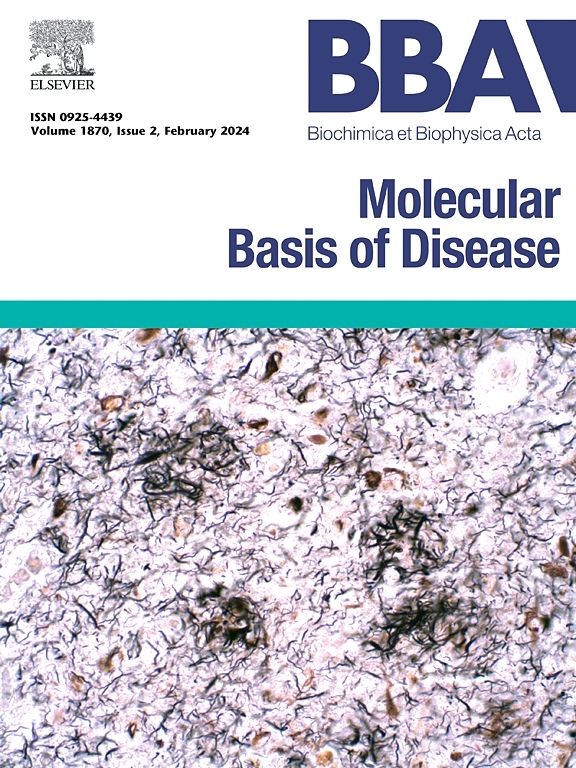肾小管特异性谷胱甘肽过氧化物酶3缺失加重IRI-AKI小鼠肾损伤
IF 4.2
2区 生物学
Q2 BIOCHEMISTRY & MOLECULAR BIOLOGY
Biochimica et biophysica acta. Molecular basis of disease
Pub Date : 2025-05-07
DOI:10.1016/j.bbadis.2025.167895
引用次数: 0
摘要
缺血-再灌注损伤是急性肾损伤(AKI)的主要诱因,主要由氧化应激驱动。其中一个关键的抗氧化防御是谷胱甘肽过氧化物酶3 (GPX3),一种由肾小管上皮细胞产生的酶。我们之前的研究已经揭示了从AKI患者和小鼠模型中收集的肾组织中GPX3的显著下调。本研究旨在探讨小管细胞特异性Gpx3缺失在小鼠模型中缺血再灌注损伤诱导的AKI (IRI-AKI)中的作用,并描述其潜在机制。通过产生肾小管上皮细胞特异性Gpx3敲除小鼠并诱导IRI-AKI,我们评估了一系列肾损伤指标,包括肾功能、氧化应激、细胞凋亡和线粒体动力学。此外,我们进行了转录组测序和生物信息学分析。结果强调,在IRI-AKI的情况下,小管细胞中GPX3的缺乏会加剧小管损伤、肾功能障碍、氧化应激、细胞凋亡和线粒体动力学紊乱。测序和生物信息学分析表明,Gpx3缺失主要影响与代谢和炎症相关的途径。总之,肾小管细胞特异性GPX3缺乏通过强化氧化应激、促进线粒体损伤、扰乱代谢过程和加剧炎症加剧肾损伤。肾小管中GPX3的靶向恢复成为缓解IRI-AKI的潜在治疗途径。本文章由计算机程序翻译,如有差异,请以英文原文为准。
Tubular specific glutathione peroxidase 3 deletion exacerbates kidney damage in IRI-AKI mice
Ischemia-reperfusion injury stands as a primary instigator of acute kidney injury (AKI), prominently driven by oxidative stress. Among the critical antioxidant defenses is glutathione peroxidase 3 (GPX3), an enzyme generated by renal tubular epithelial cells. Our prior investigations have unveiled a substantial downregulation of GPX3 in renal tissues gleaned from AKI patients and murine models. This study aims to investigate the role of tubular cell-specific Gpx3 deletion on ischemia-reperfusion injury-induced AKI (IRI-AKI) in a murine model and delineate the potential underlying mechanisms.
By generating renal tubular epithelial cell-specific Gpx3 knockout mice and inducing IRI-AKI, we assessed a spectrum of kidney injury indices including renal function, oxidative stress, apoptosis and mitochondrial dynamics. Additionally, we conducted transcriptome sequencing and bioinformatics analyses. The outcomes underscore that the deficiency of GPX3 in tubular cells exacerbates tubular injury, renal dysfunction, oxidative stress, apoptosis, and mitochondrial dynamic disturbances in the context of IRI-AKI. Sequencing and bioinformatics analysis suggest that the Gpx3 deletion predominantly impacts pathways associated with metabolism and inflammation.
In conclusion, the tubular cell-specific deficiency of GPX3 exacerbates renal injury by intensifying oxidative stress, fostering mitochondrial impairment, perturbing metabolic processes and fueling inflammation. The targeted restoration of GPX3 in the renal tubular emerges as a potential therapeutic avenue for mitigating IRI-AKI.
求助全文
通过发布文献求助,成功后即可免费获取论文全文。
去求助
来源期刊
CiteScore
12.30
自引率
0.00%
发文量
218
审稿时长
32 days
期刊介绍:
BBA Molecular Basis of Disease addresses the biochemistry and molecular genetics of disease processes and models of human disease. This journal covers aspects of aging, cancer, metabolic-, neurological-, and immunological-based disease. Manuscripts focused on using animal models to elucidate biochemical and mechanistic insight in each of these conditions, are particularly encouraged. Manuscripts should emphasize the underlying mechanisms of disease pathways and provide novel contributions to the understanding and/or treatment of these disorders. Highly descriptive and method development submissions may be declined without full review. The submission of uninvited reviews to BBA - Molecular Basis of Disease is strongly discouraged, and any such uninvited review should be accompanied by a coverletter outlining the compelling reasons why the review should be considered.

 求助内容:
求助内容: 应助结果提醒方式:
应助结果提醒方式:


